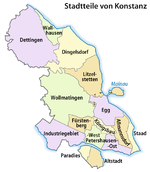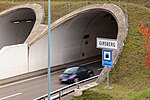Tägermoos

The Tägermoos is an area of 1.54 km2 (380 acres) in Thurgau, Switzerland, wedged between the outskirts of the German city of Constance and the core village of the Swiss municipality of Tägerwilen. It lies on the south bank of the Seerhein. In the east, it borders the district Paradies of Constance. In the south-east, it borders the district Emmishofen of the municipality of Kreuzlingen. The remarkable status of Tägermoos was fixed in 1831 by a treaty which is still in force today. Under this treaty, the area is part of Switzerland at the state level and part of the Swiss municipality of Tägerwilen. However, certain administrative tasks are exercised by the German city of Constance, in accordance with Thurgau municipal law. Other tasks are exercised by the authorities of Tägerwilen. In particular, land survey is the responsibility of Constance, making Tägermoos a Gemarkung of the city of Constance. The City of Constance legally owns about two-thirds of the land; the rest is held by Swiss authorities and private citizens. It was once a marshy commons, but has since been drained and is now mostly used for agriculture, primarily vegetable production and allotments. At the Eastern edge, there are two border crossings, the larger Tägermoos crossing and the smaller Gottlieber Zoll.
Excerpt from the Wikipedia article Tägermoos (License: CC BY-SA 3.0, Authors, Images).Tägermoos
An der vierten Strasse,
Geographical coordinates (GPS) Address Nearby Places Show on map
Geographical coordinates (GPS)
| Latitude | Longitude |
|---|---|
| N 47.66 ° | E 9.15 ° |
Address
An der vierten Strasse
An der vierten Strasse
8274
Thurgau, Switzerland
Open on Google Maps











